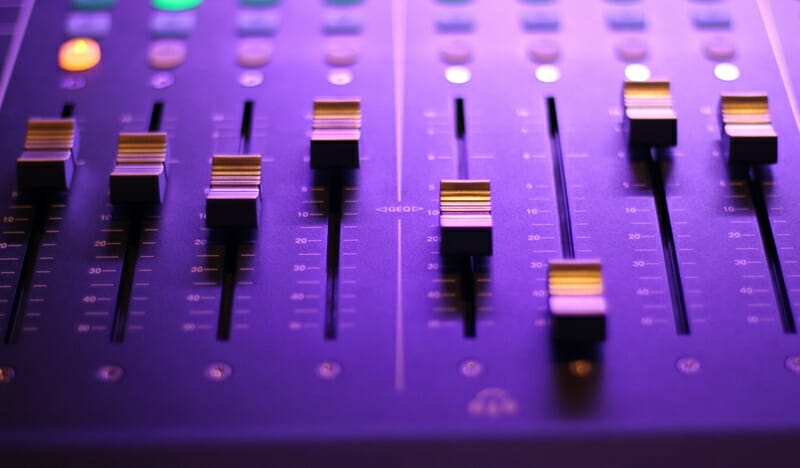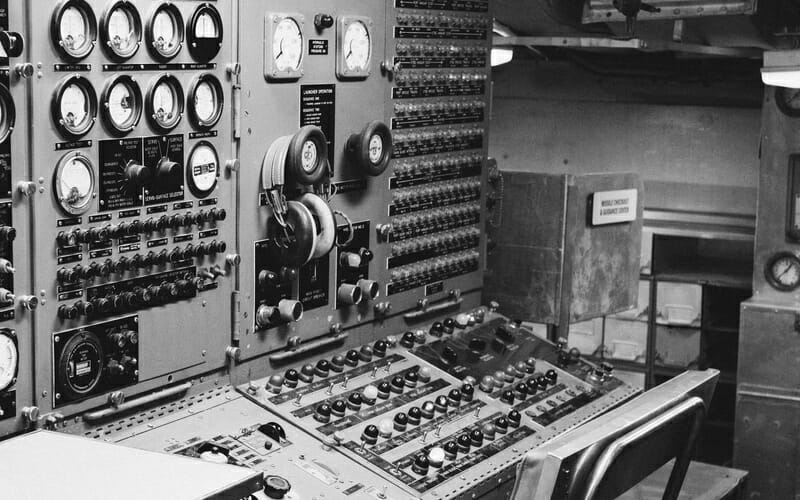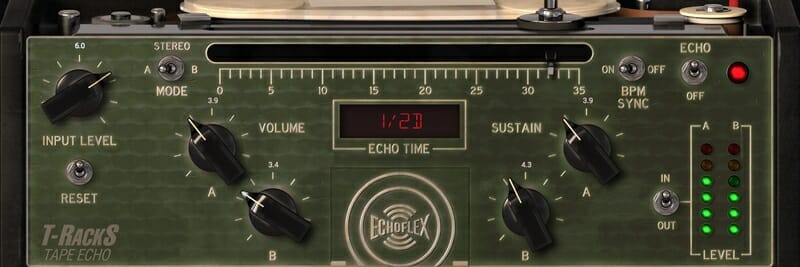Let’s say your typical stock delay plugin isn’t cutting it.
You want that vintage delay sound, but you also want hints of saturation, chorus, and some extra harmonics.
That’s where tape delay can come in.
What is Tape Delay?

Tape delay uses an analog tape recorder to get a certain delay or echo effect.
Back in the day, engineers created delay by routing a signal from one tape recorder to a second tape recorder. It would reach the second tape recorder after the first one, creating a delay effect.
There were other things engineers could do to alter the delay, like routing the signal from the second tape recorder back to the first.
As cool and innovative as tape delay was, it had its downsides. Because it was tape, the recording quality wasn’t the best. The more you use it, the more worn it gets, and the quality diminishes. Within a delay effect, the quality would degrade with each repetition.
Eventually, people made analog devices that were made for delay. And then people started creating digital devices that would emulate tape delay.
Even today, there are plenty of tape delay plugins that sound a lot like their analog ancestors, although some purists would disagree. In fact, some engineers prefer analog tape machines because it produces a very unique delay sound.
The original tape delay method would add warm, wide, and lush sounds. It even creates extra harmonics that can elevate your mix. So you can imagine why it’s in such high demand.
Why Use Tape Delay?

Typical delay does pretty much one thing: repeat audio for an echoey effect.
And that’s good. Sometimes that’s exactly what you need.
But tape delay does more than just delay, even though that’s its main purpose. It’s a multi-faceted effect.
Not only does tape delay give you a cool, lo-fi, vintage delay sound, but it also warms up your mix with some saturation. It can add a chorus-like effect or some slapback delay, depending on your settings.
Overall, it can add harmonics and complexity to your audio.
But only if you do it right…
How To Use Tape Delay
So how can you use tape delay without a tape machine?
Here are three ways to get creative with tape delay…
Saturation

Yes, there are already other plugins specifically for saturation. But if you can add delay and saturate your mix, why not?
Usually, you’d have to think about when to saturate an element. But with tape delay, you get natural saturation as you add delay.
Basically, the tape delay overloads the higher volumes, creating a saturation effect.
Chorus
An effect similar to delay is chorus, and tape delay gives you a subtle chorus effect.
Now, if you want a full-fledged chorus effect, just use a chorus plugin. But by using tape delay, you also get a hint of chorus.
Lo-fi effect

Maybe you want a lo-fi feel to your track, whether you like the vintage sound or you want to glue things together a bit.
Mess around with the speed and flutter of your tape delay until you get a lower fidelity sound. This will also give you a more lush sound.
Add complexity
You can add extra repeats to your tape delay by increasing the feedback. This can boost the complexity and dimensions of your delay.
You can loop the feedback back into your tape delay to create and more space in your mix, especially on your vocals.
Slapback delay
Slapback delay has a delay time of around 75-200 milliseconds. So if you set the delay time on your tape delay plugin to within that range, you’ve got slapback.
Using tape delay to get some slapback delay can add some width, depth, and energy to your mix. If you use a faster delay time, it can make the song feel a bit more energetic. But if you use a slower delay time, it can make the audio feel more spacious.
The Best Tape Delay Plugins
I’m guessing you don’t want to buy a tape machine, let alone learn how to use it.
So here are some of the best tape delay plugins you can start using right now.
Logic Tape Delay

If you have Logic, you have access to their tape delay plugin.
You can sync the delay to your project tempo or you can let it be free. You can also add a lowpass and/or highpass filter within the feedback loop, which creates a natural sounding echo effect.
You can also produce a subtle chorus with an LFO (low-frequency oscillation) by modulating the delay time.
E-phonic Tape Delay

If you’re looking for simplicity, E-phonic’s tape delay plugin is your answer. E-phonic gives you the warmness you expect from analog tape delay.
You get up to one second of delay, you can use a highpass or lowpass filter, and you can add noise for self-resonance.
Plus, it’s totally free.
IK Multimedia Tape Echo

IK Multimedia’s tape echo closely emulates analog tape sounds, like tape hiss, wear, and flutter.
So you can use it for a classic tape analog sound, or you can take the settings to their limit to create super interesting effects.
It’s about $80, but it’s worth it if you have the budget.
Soundtoys EchoBoy

Soundtoys’ EchoBoy does a great job of emulating that classic analog tape delay you want. It’s warm, it has a nice chorus effect, and it’s easy to use.
This is the most expensive plugin on this list, coming in at about $200. But it’s for sure the highest quality tape delay plugin I’ve mentioned.
Conclusion
If you want a vintage delay sound with a bit of saturation, chorus, harmonics, and reverby-ness, then tape delay is a good option for you.
And you can get a quality tape delay plugin regardless of your budget.









